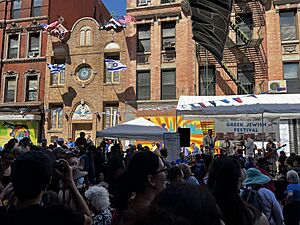Kehila Kedosha Janina facts for kids
Quick facts for kids Kehila Kedosha Janina |
|
|---|---|

Kehila Kedosha Janina synagogue in 2007
|
|
| Religion | |
| Affiliation | Judaism |
| Rite | Romaniote |
| Ecclesiastical or organizational status | Synagogue |
| Leadership | Lay led |
| Status | Active |
| Location | |
| Location | 280 Broome Street, Manhattan, New York City, New York |
| Country | United States |
| Architecture | |
| Architect(s) | Sydney Daub |
| Architectural type | Synagogue |
| Architectural style |
|
| Date established | 1906 (as a congregation) |
| Completed | 1927 |
| Specifications | |
| Width | 20 feet (6.1 m) |
| Materials | Brick; stone |
Kehila Kedosha Janina is a special synagogue in New York City. Its name means "Holy Community of Janina." You can find it on Broome Street in the Lower East Side of Manhattan. This synagogue is unique because it is the only one in the Western Hemisphere that follows the Romaniote rite.
Romaniote traditions are different from other Jewish groups like Sephardic and Ashkenazi Judaism. Their history goes back almost 2000 years in the Eastern Mediterranean.
The synagogue building was constructed between 1925 and 1927. Sydney Daub designed it using Classical Revival and Moorish Revival styles. It became a National Register of Historic Places site in 1999. In 2004, it was also named a New York City Landmark. The synagogue was carefully restored in 2006.
Contents
History of Kehila Kedosha Janina
Kehila Kedosha Janina is the only Romaniote synagogue in the Western Hemisphere. The community started in 1906. It was founded by Jewish immigrants from Ioannina, Greece. The synagogue building itself was finished in 1927.
The years before Second World War were a busy time for the Romaniote community. There were three rabbis at the synagogue. During important Jewish holidays, the synagogue was often so full that people had to stand. After the Second World War, many members moved to other parts of New York City. They went to places like Harlem, the Bronx, and Brooklyn.
Even though the community has become smaller since its busiest days, services are still held. They have services on shabbat (the Jewish day of rest) and other Jewish holidays. The synagogue sends updates to about 5,000 people. Sometimes, it can be hard to gather enough people for a minyan, which is the minimum number of adults needed for a public worship service. Guided tours are offered every Sunday for visitors.
The Janina community also has a burial plot at Wellwood Cemetery. There is a special memorial there. It remembers the Jews from Ioannina who were killed during the Shoah, a terrible event in history.
Inside the Synagogue Building
The layout of Kehila Kedosha Janina is a bit different from other Romaniote synagogues. Usually, Romaniote synagogues face east to west. This one faces north to south. The Ehal, which holds the Torah scrolls, is on the north side.
The bimah, where the Torah is read, is in the middle of the main room. In most Romaniote synagogues, the bimah is on the west wall. There is also an inside staircase for the women's balcony. Like all Orthodox synagogues, men and women sit separately.
The second floor has the women's gallery. This area also has a museum. The museum shows artifacts, exhibits, and Jewish items. These displays teach about Jewish life in Greece and the history of Greek Jews. There is also a gift shop. The items are displayed in cases along the walls.
Greek Jewish Festival
To help raise money, Kehila Kedosha Janina holds an annual Greek Jewish Festival. This festival usually happens around May. It features live music, delicious food, and fun activities for kids. During the festival, the Kehila Kedosha Janina Museum also offers tours.
See also
 In Spanish: Sinagoga Kehila Kedosha Janina para niños
In Spanish: Sinagoga Kehila Kedosha Janina para niños
- List of New York City Designated Landmarks in Manhattan below 14th Street
- National Register of Historic Places listings in Manhattan below 14th Street
- Kehila Kedosha Yashan Synagogue
- Yanina Synagogue



